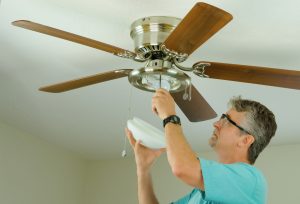The Ceiling Fan - Get Ready for Summer

Believe it or not, summer is just around the corner. So you’ll need to start thinking about whether you want to go for the classic air conditioning unit, or a ceiling fan.
Ceiling fans are loved and hated in almost equal measure. Everyone has an opinion on them. For many people, they add a touch of character and style to a room. For others, they are an ancient relic of the past, and that is where they should stay.
However, while they have no shortage of critics, ceiling fans have a lot to offer. It’s true that they were first in style many years ago, but today they’re back, updated, and there are so many different designs on offer.
In today’s article, we’ll talk about the ceiling fan, their advantages and disadvantages, and the different types you can find on the market at the moment.
Ceiling fan vs. air conditioner
There are many ways to combat the heat in summer. For example, you can open the windows very early in the day to let a breeze in, and close it afterwards before it gets warm. You can also pull down the blinds or close the curtains and shutters, or – of course – install air conditioning.
However, many people cannot afford air conditioning in their homes. It is expensive and usually requires a lot of work to install it. Sometimes the installation can be more trouble than it’s worth.

Ceilings fans are therefore a great alternative if you want to avoid all this.
Let’s take a look at some of their advantages.
Advantages ceiling fans
One of the main advantages of ceiling fans is that they are better for your health than air conditioning.
Air conditioning has been linked to many health conditions. For example, skin problems, colds, eye irritation and lumbago.
Secondly, the economic factor is an important one. Ceiling fans are much cheaper than air conditioners.
Plus, they waste 90% less energy than air conditioners, making them a greener way to cool your home.
Better still, ceiling fans are easy to install. All you need is a sufficiently strong light fixture.
Another advantage of the ceiling fan is their look. On today’s market, you can find almost any design, size, color and material imaginable.
From the classical to the sophisticated, or even the futuristic, you can find pretty much any design you can think of. Air conditioners on the other hand aren’t exactly decorative…
The last advantage is linked with insects. Yes, believe it or not, ceiling fans are the perfect way to keep pesky mosquitoes at bay in the summer.
The sound produced by the spinning blades is horrible to insects, so your fan will make sure your room is bug-free.
Disadvantages of ceiling fans
One of the main disadvantages of the ceiling fan is that it can only circulate air. It can’t cool it down like air conditioners.
What’s more, if you don’t have it installed at the right height, it can be dangerous for children.
Number of blades
The minimum number of blades on a ceiling fan is two, but there can be as many as ten. These are known as multi-blade fans.
However, fans with three blades are the most efficient, as they are more aerodynamic than the five-bladed fan. You’ll normally find ceiling fans with four or five blades in stores.
Materials
Wood is the classic ceiling fan material, although you’ll also find other, industrial-style metallic models, or even wicker ones. The most innovative are the methacrylate models, which are perfect for more modern or minimalist-style homes.
The shape of the blades
You can generally find three different types of ceiling fans according to the shape of the blades.
- Classic: The blades are long and rectangular.
- Spade: This shape is more exotic and brings to mind the fans used in tropical rain forests.
- Ergonomic: These fans have less defined, more organic shapes, with a more futuristic and modern design. This shape would fit perfectly with Nordic-style decor.
How to choose the right ceiling fan

If you decide to go for a ceiling fan, you’ll need to keep the following things in mind:
- The size of the ceiling fan will depend on the size of the room. It’s not just a question of proportions and creating a balanced space. It’s also because small rooms don’t need as much cooling as large rooms. For rooms between 250-300 square feet, we recommend that you use a fan measuring 50 inches +. For rooms measuring more than 300 square feet, you might want to have more than one ceiling fan.
- It’s also important to get the right height for your fan. Too low, and it can be dangerous. If you have low ceilings, ceiling fans might not actually be the best option for you. The recommended ceiling height for a fan is around 8 feet, although if it’s higher you can also buy a longer mounting bracket for your fan.
- The ceiling fan should be in the center of the room to circulate the air evenly. It’s also important that there are no nearby obstacles for your fan to hit.
- If you’re worried about noise, choose a fan with wooden or methacrylate blades.
Conclusion
As we’ve seen, if you want to keep your house cool in summer, ceiling fans are a cheaper alternative to air conditioning. They’re also more ecological and better for your health.
What’s more, unlike the traditional air conditioning system, they’re also a decorative item. Their design, color and shape should therefore match the decoration in your room.
Believe it or not, summer is just around the corner. So you’ll need to start thinking about whether you want to go for the classic air conditioning unit, or a ceiling fan.
Ceiling fans are loved and hated in almost equal measure. Everyone has an opinion on them. For many people, they add a touch of character and style to a room. For others, they are an ancient relic of the past, and that is where they should stay.
However, while they have no shortage of critics, ceiling fans have a lot to offer. It’s true that they were first in style many years ago, but today they’re back, updated, and there are so many different designs on offer.
In today’s article, we’ll talk about the ceiling fan, their advantages and disadvantages, and the different types you can find on the market at the moment.
Ceiling fan vs. air conditioner
There are many ways to combat the heat in summer. For example, you can open the windows very early in the day to let a breeze in, and close it afterwards before it gets warm. You can also pull down the blinds or close the curtains and shutters, or – of course – install air conditioning.
However, many people cannot afford air conditioning in their homes. It is expensive and usually requires a lot of work to install it. Sometimes the installation can be more trouble than it’s worth.

Ceilings fans are therefore a great alternative if you want to avoid all this.
Let’s take a look at some of their advantages.
Advantages ceiling fans
One of the main advantages of ceiling fans is that they are better for your health than air conditioning.
Air conditioning has been linked to many health conditions. For example, skin problems, colds, eye irritation and lumbago.
Secondly, the economic factor is an important one. Ceiling fans are much cheaper than air conditioners.
Plus, they waste 90% less energy than air conditioners, making them a greener way to cool your home.
Better still, ceiling fans are easy to install. All you need is a sufficiently strong light fixture.
Another advantage of the ceiling fan is their look. On today’s market, you can find almost any design, size, color and material imaginable.
From the classical to the sophisticated, or even the futuristic, you can find pretty much any design you can think of. Air conditioners on the other hand aren’t exactly decorative…
The last advantage is linked with insects. Yes, believe it or not, ceiling fans are the perfect way to keep pesky mosquitoes at bay in the summer.
The sound produced by the spinning blades is horrible to insects, so your fan will make sure your room is bug-free.
Disadvantages of ceiling fans
One of the main disadvantages of the ceiling fan is that it can only circulate air. It can’t cool it down like air conditioners.
What’s more, if you don’t have it installed at the right height, it can be dangerous for children.
Number of blades
The minimum number of blades on a ceiling fan is two, but there can be as many as ten. These are known as multi-blade fans.
However, fans with three blades are the most efficient, as they are more aerodynamic than the five-bladed fan. You’ll normally find ceiling fans with four or five blades in stores.
Materials
Wood is the classic ceiling fan material, although you’ll also find other, industrial-style metallic models, or even wicker ones. The most innovative are the methacrylate models, which are perfect for more modern or minimalist-style homes.
The shape of the blades
You can generally find three different types of ceiling fans according to the shape of the blades.
- Classic: The blades are long and rectangular.
- Spade: This shape is more exotic and brings to mind the fans used in tropical rain forests.
- Ergonomic: These fans have less defined, more organic shapes, with a more futuristic and modern design. This shape would fit perfectly with Nordic-style decor.
How to choose the right ceiling fan

If you decide to go for a ceiling fan, you’ll need to keep the following things in mind:
- The size of the ceiling fan will depend on the size of the room. It’s not just a question of proportions and creating a balanced space. It’s also because small rooms don’t need as much cooling as large rooms. For rooms between 250-300 square feet, we recommend that you use a fan measuring 50 inches +. For rooms measuring more than 300 square feet, you might want to have more than one ceiling fan.
- It’s also important to get the right height for your fan. Too low, and it can be dangerous. If you have low ceilings, ceiling fans might not actually be the best option for you. The recommended ceiling height for a fan is around 8 feet, although if it’s higher you can also buy a longer mounting bracket for your fan.
- The ceiling fan should be in the center of the room to circulate the air evenly. It’s also important that there are no nearby obstacles for your fan to hit.
- If you’re worried about noise, choose a fan with wooden or methacrylate blades.
Conclusion
As we’ve seen, if you want to keep your house cool in summer, ceiling fans are a cheaper alternative to air conditioning. They’re also more ecological and better for your health.
What’s more, unlike the traditional air conditioning system, they’re also a decorative item. Their design, color and shape should therefore match the decoration in your room.







